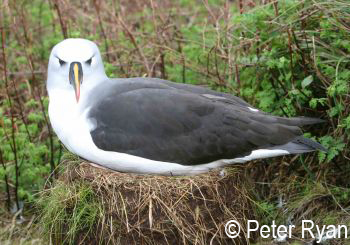The United Kingdom's Overseas Territory of Tristan da Cunha in the South Atlantic Ocean is comprised of four main islands, three of which are not permanently inhabited. Two of these "outer" islands, Gough and Inaccessible, are nature reserves, Ramsar Wetlands of International Importance and together from a single World Heritage natural site. Each island has its own management plan, currently being combined and updated into a single World Heritage plan.
In contrast, the third uninhabited island, Nightingale, which like the other Tristan islands and along with its outlying islets of Stoltenhoff and Middle (click here for a report of a recent visit to these two islets), supports important populations of ACAP-listed Atlantic Yellow-nosed Thalassarche chlororhynchos (a Tristan group endemic) and Dark-mantled Sooty Phoebetria fusca Albatrosses, does not as yet have a dedicated management plan.
Nightingale, unlike Gough and Inaccessible, is regularly visited by Tristan Islanders (although exploitation of ACAP-listed species is no longer permitted), and from time to time by tourists from cruise ships.
The situation is now set to change as funding is reported in the June 2010 issue (No. 36) of the UK Overseas Territories Conservation Forum's newsletter, Forum News (click here) as being granted to the UK's Royal Society for the Protection of Birds (RSPB) by the UK Overseas Territories Environment Programme (OTEP) to, inter alia, produce a manplan for Nightingale, as well as for specific areas on the inhabited main island of Tristan itself (where already all the penguin colonies are designated nature reserves).
More detailed information on the new Tristan grant entitled "Integrated Biodiversity Management Planning on Tristan da Cunha (OTEP TDC 701)" may be found at http://www.ukotcf.org/infoDB/infoSourcesDetail2.cfm?module=projects&refID=275.
The newly funded project will also aim to continue capacity-building efforts within the Tristan da Cunha Conservation Department that was formed in 2009. The Tristan Biodiversity Action Plan of 2006-2010 will be reviewed and updated, and training will be delivered to Conservation Department staff and its associates.

With Nightingale set to receive its own management plan, there will be very few breeding localities for ACAP-listed albatrosses and petrels in the Southern Ocean that do not already have such plans in place (click here for a listing of existing plans).
John Cooper, ACAP Information Officer, 15 July 2010

 English
English  Français
Français  Español
Español